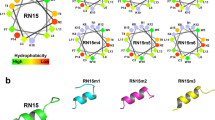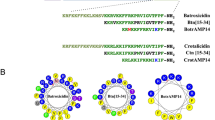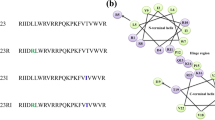Abstract
Antimicrobial peptides (AMPs) have the potential to treat multidrug-resistant bacterial infections. Cathelicidins are a class of cationic antimicrobial peptides that are found in nearly all vertebrates. Herein, we determined the mature peptide region of Alligator sinensis cathelicidin by comparing its cathelicidin peptide sequence with those of other reptiles and designed nine peptide mutants based on the Alligator sinensis cathelicidin mature peptide. According to the antibacterial activity and cytotoxicity screening, the peptide AS-12W demonstrated broad-spectrum antibacterial activity and exhibited low erythrocyte hemolytic activity. In particular, AS-12W exhibited strong antibacterial activity and rapid bactericidal activity against carbapenem-resistant Pseudomonas aeruginosa in vitro. Additionally, AS-12W effectively removed carbapenem-resistant P. aeruginosa from blood and organs in vivo, leading to improved survival rates in septic mice. Furthermore, AS-12W exhibited good stability and tolerance to harsh conditions such as high heat, high salt, strong acid, and strong alkali, and it also displayed high stability toward trypsin and simulated gastric fluid (SGF). Moreover, AS-12W showed significant anti-inflammatory effects in vitro by inhibiting the production of proinflammatory factors induced by lipopolysaccharide (LPS). Due to its antibacterial mechanism against Escherichia coli, we found that this peptide could neutralize the negative charge on the surface of the bacteria and disrupt the integrity of the bacterial cell membrane. In addition, AS-12W has the ability to bind to the genomic DNA of bacteria and stimulate the production of reactive oxygen species (ROS) within bacteria, which is believed to be the reason for the good antibacterial activity of AS-12W. These results demonstrated that AS-12W exhibits remarkable antibacterial activity, particularly against carbapenem-resistant P. aeruginosa. Therefore, it is a potential candidate for antibacterial drug development.






Similar content being viewed by others
Data Availability
No datasets were generated or analysed during the current study.
References
Huemer M, Mairpady Shambat S, Brugger SD, Zinkernagel AS (2020) Antibiotic resistance and persistence-implications for human health and treatment perspectives. EMBO Reports 21(12):e51034. https://doi.org/10.15252/embr.202051034
Luo Y, Song Y (2021) Mechanism of antimicrobial peptides: antimicrobial, anti-inflammatory and antibiofilm activities. Int J Mol Sci 22(21):11401. https://doi.org/10.3390/ijms222111401
Florin T, Maracci C, Graf M, Karki P, Klepacki D, Berninghausen O et al (2017) An antimicrobial peptide that inhibits translation by trapping release factors on the ribosome. Nat Struct Mol Biol 24(9):752–757. https://doi.org/10.1038/nsmb.3439
Chung EMC, Dean SN, Propst CN, Bishop BM, van Hoek ML (2017) Komodo dragon-inspired synthetic peptide DRGN-1 promotes wound-healing of a mixed-biofilm infected wound. NPJ Biofilms Microbiomes 3:9. https://doi.org/10.1038/s41522-017-0017-2
Liu G, Yang F, Li F, Li Z, Lang Y, Shen B et al (2018) Therapeutic potential of a scorpion venom-derived antimicrobial peptide and its homologs against antibiotic-resistant gram-positive bacteria. Front Microbiol 9:1159. https://doi.org/10.3389/fmicb.2018.01159
Kobras CM, Piepenbreier H, Emenegger J, Sim A, Fritz G, Gebhard S (2020) BceAB-type antibiotic resistance transporters appear to act by target protection of cell wall synthesis. Antimicrob Agents Chemother 64(3):e02241–19. https://doi.org/10.1128/aac.02241-19
Dias SA, Freire JM, Pérez-Peinado C, Domingues MM, Gaspar D, Vale N et al (2017) New potent membrane-targeting antibacterial peptides from viral capsid proteins. Front Microbiol 8:775. https://doi.org/10.3389/fmicb.2017.00775
Kasus-Jacobi A, Noor-Mohammadi S, Griffith GL, Hinsley H, Mathias L, Pereira HA (2015) A multifunctional peptide based on the neutrophil immune defense molecule, CAP37, has antibacterial and wound-healing properties. J Leukoc Biol 97(2):341–350. https://doi.org/10.1189/jlb.3A0214-104RR
van Hoek ML (2014) Antimicrobial peptides in reptiles. Pharmaceuticals (Basel, Switzerland) 7(6):723–753. https://doi.org/10.3390/ph7060723
Zanetti M, Gennaro R, Scocchi M, Skerlavaj B (2000) Structure and biology of cathelicidins. Adv Exp Med Biol 479:203–218. https://doi.org/10.1007/0-306-46831-x_17
Kim D, Soundrarajan N, Lee J, Cho HS, Choi M, Cha SY et al (2017) Genomewide analysis of the antimicrobial peptides in Python bivittatus and characterization of cathelicidins with potent antimicrobial activity and low cytotoxicity. Antimicrob Agents Chemother 61(9):e00530–17. https://doi.org/10.1128/aac.00530-17
Zhao L, Cao Z, Bian Y, Hu G, Wang J, Zhou Y (2018) Molecular dynamics simulations of human antimicrobial peptide LL-37 in model POPC and POPG lipid bilayers. Int J Mol Sci 19(4):1186. https://doi.org/10.3390/ijms19041186
Yoo JH, Ho S, Tran DH, Cheng M, Bakirtzi K, Kukota Y et al (2015) Anti-fibrogenic effects of the anti-microbial peptide cathelicidin in murine colitis-associated fibrosis. Cell Mol Gastroenterol Hepatol 1(1):55-74.e51. https://doi.org/10.1016/j.jcmgh.2014.08.001
Emam M, Caballero-Solares A, Xue X, Umasuthan N, Milligan B, Taylor RG et al (2022) Gill and liver transcript expression changes associated with gill damage in Atlantic salmon (Salmo salar). Front Immunol 13:806484. https://doi.org/10.3389/fimmu.2022.806484
Criscitiello MF, Kraev I, Petersen LH, Lange S (2020) Deimination protein profiles in Alligator mississippiensis reveal plasma and extracellular vesicle-specific signatures relating to immunity, metabolic function, and gene regulation. Front Immunol 11:651. https://doi.org/10.3389/fimmu.2020.00651
Hu MY, Chen YW, Chai ZF, Wang YZ, Lin JQ, Fang SG (2022) Antibacterial properties and potential mechanism of serum from Chinese Alligator. Microorganisms 10(11):2210. https://doi.org/10.3390/microorganisms10112210
Wan QH, Pan SK, Hu L, Zhu Y, Xu PW, Xia JQ et al (2013) Genome analysis and signature discovery for diving and sensory properties of the endangered Chinese alligator. Cell Res 23(9):1091–1105. https://doi.org/10.1038/cr.2013.104
Zhong L, Liu J, Teng S, Xie Z (2020) Identification of a novel cathelicidin from the Deinagkistrodon acutus genome with antibacterial activity by multiple mechanisms. Toxins 12(12):771. https://doi.org/10.3390/toxins12120771
Cai S, Qiao X, Feng L, Shi N, Wang H, Yang H et al (2018) Python cathelicidin CATHPb1 protects against multidrug-resistant Staphylococcal infections by antimicrobial-immunomodulatory duality. J Med Chem 61(5):2075–2086. https://doi.org/10.1021/acs.jmedchem.8b00036
Wiegand I, Hilpert K, Hancock RE (2008) Agar and broth dilution methods to determine the minimal inhibitory concentration (MIC) of antimicrobial substances. Nat Protoc 3(2):163–175. https://doi.org/10.1038/nprot.2007.521
Ma L, Xie X, Liu H, Huang Y, Wu H, Jiang M et al (2020) Potent antibacterial activity of MSI-1 derived from the magainin 2 peptide against drug-resistant bacteria. Theranostics 10(3):1373–1390. https://doi.org/10.7150/thno.39157
Wu J, Abbas HMK, Li J, Yuan Y, Liu Y, Wang G et al (2019) Cell membrane-interrupting antimicrobial peptides from Isatis indigotica fortune isolated by a Bacillus subtilis expression system. Biomolecules 10(1):30. https://doi.org/10.3390/biom10010030
Li Y, Gould A, Aboye T, Bi T, Breindel L, Shekhtman A et al (2017) Full sequence amino acid scanning of θ-defensin RTD-1 yields a potent anthrax lethal factor protease inhibitor. J Med Chem 60(5):1916–1927. https://doi.org/10.1021/acs.jmedchem.6b01689
Dong H, Yang K, Zhang Y, Li Q, Xiu W, Ding M et al (2022) Photocatalytic Cu(2)WS(4) nanocrystals for efficient bacterial killing and biofilm disruption. Int J Nanomed 17:2735–2750. https://doi.org/10.2147/ijn.S360246
Wu H, Xu P, Huang Y, Wang L, Ye X, Huang X et al (2021) PCL-1, a trypsin-resistant peptide, exerts potent activity against drug-resistant bacteria. Probiotics Antimicrob Proteins 13(5):1467–1480. https://doi.org/10.1007/s12602-021-09801-8
Liu Y, Xia X, Xu L, Wang Y (2013) Design of hybrid β-hairpin peptides with enhanced cell specificity and potent anti-inflammatory activity. Biomaterials 34(1):237–250. https://doi.org/10.1016/j.biomaterials.2012.09.032
Tram NDT, Selvarajan V, Boags A, Mukherjee D, Marzinek JK, Cheng B et al (2021) Manipulating turn residues on de novo designed β-hairpin peptides for selectivity against drug-resistant bacteria. Acta Biomater 135:214–224. https://doi.org/10.1016/j.actbio.2021.09.004
Yu H, Wang C, Feng L, Cai S, Liu X, Qiao X et al (2017) Cathelicidin-trypsin inhibitor loop conjugate represents a promising antibiotic candidate with protease stability. Sci Rep 7(1):2600. https://doi.org/10.1038/s41598-017-02050-2
Wei L, Gao J, Zhang S, Wu S, Xie Z, Ling G et al (2015) Identification and characterization of the first cathelicidin from sea snakes with potent antimicrobial and anti-inflammatory activity and special mechanism. J Biol Chem 290(27):16633–16652. https://doi.org/10.1074/jbc.M115.642645
Ye X, Wang J, Xu P, Yang X, Shi Q, Liu G et al (2023) Peptide MSI-1 inhibited MCR-1 and regulated outer membrane vesicles to combat immune evasion of Escherichia coli. Microb Biotechnol 16(9):1755–1773. https://doi.org/10.1111/1751-7915.14297
Rajasekaran G, Kumar SD, Yang S, Shin SY (2019) The design of a cell-selective fowlicidin-1-derived peptide with both antimicrobial and anti-inflammatory activities. Eur J Med Chem 182:111623. https://doi.org/10.1016/j.ejmech.2019.111623
Ma L, Wang Y, Wang M, Tian Y, Kang W, Liu H et al (2016) Effective antimicrobial activity of Cbf-14, derived from a cathelin-like domain, against penicillin-resistant bacteria. Biomaterials 87:32–45. https://doi.org/10.1016/j.biomaterials.2016.02.011
Dong N, Chou S, Li J, Xue C, Li X, Cheng B et al (2018) Short symmetric-end antimicrobial peptides centered on β-turn amino acids unit improve selectivity and stability. Front Microbiol 9:2832. https://doi.org/10.3389/fmicb.2018.02832
Sun C, Gu L, Hussain MA, Chen L, Lin L, Wang H et al (2019) Characterization of the bioactivity and mechanism of bactenecin derivatives against food-pathogens. Front Microbiol 10:2593. https://doi.org/10.3389/fmicb.2019.02593
Li Q, Chen S, Zhu K, Huang X, Huang Y, Shen Z et al (2022) Collateral sensitivity to pleuromutilins in vancomycin-resistant Enterococcus faecium. Nat Commun 13(1):1888. https://doi.org/10.1038/s41467-022-29493-0
Nam J, Yun H, Rajasekaran G, Kumar SD, Kim JI, Min HJ et al (2018) Structural and functional assessment of mBjAMP1, an antimicrobial peptide from Branchiostoma japonicum, revealed a novel α-hairpinin-like scaffold with membrane permeable and DNA binding activity. J Med Chem 61(24):11101–11113. https://doi.org/10.1021/acs.jmedchem.8b01135
Mao C, Wang Y, Yang Y, Li L, Yuan K, Cao H et al (2022) Cec4-derived peptide inhibits planktonic and biofilm-associated methicillin resistant Staphylococcus epidermidis. Microbiology spectrum 10(6):e0240922. https://doi.org/10.1128/spectrum.02409-22
Liu L, Wang C, Zhang M, Zhang Z, Wu Y, Zhang Y (2022) An efficient evaluation system accelerates α-helical antimicrobial peptide discovery and its application to global human genome mining. Front Microbiol 13:870361. https://doi.org/10.3389/fmicb.2022.870361
Chen YC, Qiu W, Zhang W, Zhang J, Chen R, Chen F et al (2022) A novel antimicrobial peptide Sp-LECin with broad-spectrum antimicrobial activity and anti-Pseudomonas aeruginosa infection in zebrafish. Int J Mol Sci 24(1):267. https://doi.org/10.3390/ijms24010267
Barksdale SM, Hrifko EJ, van Hoek ML (2017) Cathelicidin antimicrobial peptide from Alligator mississippiensis has antibacterial activity against multi-drug resistant Acinetobacter baumanii and Klebsiella pneumoniae. Dev Comp Immunol 70:135–144. https://doi.org/10.1016/j.dci.2017.01.011
Ma L, Ye X, Sun P, Xu P, Wang L, Liu Z et al (2020) Antimicrobial and antibiofilm activity of the EeCentrocin 1 derived peptide EC1-17KV via membrane disruption. EBioMedicine 55:102775. https://doi.org/10.1016/j.ebiom.2020.102775
Thao NP, Luyen BT, Koo JE, Kim S, Koh YS, Cuong NX et al (2015) Anti-inflammatory components of the Vietnamese starfish Protoreaster nodosus. Biol Res 48(1):12. https://doi.org/10.1186/s40659-015-0002-2
Ono H, Ohta R, Kawasaki Y, Niwa A, Takada H, Nakahata T et al (2018) Lysosomal membrane permeabilization causes secretion of IL-1β in human vascular smooth muscle cells. Inflammation research: official journal of the European Histamine Research Society 67(10):879–889. https://doi.org/10.1007/s00011-018-1178-z
Xuan J, Feng W, Wang J, Wang R, Zhang B, Bo L et al (2023) Antimicrobial peptides for combating drug-resistant bacterial infections. Drug resistance updates : reviews and commentaries in antimicrobial and anticancer chemotherapy. 68:100954. https://doi.org/10.1016/j.drup.2023.100954
Vejzovic D, Piller P, Cordfunke RA, Drijfhout JW, Eisenberg T, Lohner K et al (2022) Where electrostatics matter: bacterial surface neutralization and membrane disruption by antimicrobial peptides SAAP-148 and OP-145. Biomolecules 12(9):1252. https://doi.org/10.3390/biom12091252
Lee BS, Chen YJ, Wei TC, Ma TL, Chang CC (2018) Comparison of antibacterial adhesion when salivary pellicle is coated on both poly(2-hydroxyethyl-methacrylate)- and polyethylene-glycol-methacrylate-grafted poly(methyl methacrylate). Int J Mol Sci 19(9):2764. https://doi.org/10.3390/ijms19092764
Storey D, McNally A, Åstrand M, Sa-Pessoa Graca Santos J, Rodriguez-Escudero I, Elmore B et al (2020) Klebsiella pneumoniae type VI secretion system-mediated microbial competition is PhoPQ controlled and reactive oxygen species dependent. PLoS Pathogens 16(3):e1007969. https://doi.org/10.1371/journal.ppat.1007969
Keshavjee B, Lambelet V, Coppola H, Viertl D, Prior JO, Kappeler L et al (2022) Stress-induced premature senescence related to oxidative stress in the developmental programming of nonalcoholic fatty liver disease in a rat model of intrauterine growth restriction. Antioxidants 11(9):1695. https://doi.org/10.3390/antiox11091695
Brendish NJ, Malachira AK, Armstrong L, Houghton R, Aitken S, Nyimbili E et al (2017) Routine molecular point-of-care testing for respiratory viruses in adults presenting to hospital with acute respiratory illness (ResPOC): a pragmatic, open-label, randomised controlled trial. Lancet Respir Med 5(5):401–411. https://doi.org/10.1016/s2213-2600(17)30120-0
Dieltjens L, Appermans K, Lissens M, Lories B, Kim W, Van der Eycken EV et al (2020) Inhibiting bacterial cooperation is an evolutionarily robust anti-biofilm strategy. Nat Commun 11(1):107. https://doi.org/10.1038/s41467-019-13660-x
Tan T, Wu D, Li W, Zheng X, Li W, Shan A (2017) High specific selectivity and membrane-active mechanism of synthetic cationic hybrid antimicrobial peptides based on the peptide FV7. Int J Mol Sci 18(2):339. https://doi.org/10.3390/ijms18020339
Lian S, Lin X, Zhan F, Shen X, Liang Y, Li C (2022) Transcriptome analysis reveals the multiple functions of pBD2 in IPEC-J2 cells against E. coli. Int J Mol Sci 23(17):9754. https://doi.org/10.3390/ijms23179754
Bennett RC, Oh MW, Kuo SH, Belo Y, Maron B, Malach E et al (2021) Random peptide mixtures as safe and effective antimicrobials against Pseudomonas aeruginosa and MRSA in mouse models of bacteremia and pneumonia. ACS Infect Dis 7(3):672–680. https://doi.org/10.1021/acsinfecdis.0c00871
Sun C, Li Y, Cao S, Wang H, Jiang C, Pang S et al (2018) Antibacterial activity and mechanism of action of bovine lactoferricin derivatives with symmetrical amino acid sequences. Int J Mol Sci 19(10):2951. https://doi.org/10.3390/ijms19102951
Luo Y, McLean DT, Linden GJ, McAuley DF, McMullan R, Lundy FT (2017) The naturally occurring host defense peptide, LL-37, and its truncated mimetics KE-18 and KR-12 have selected biocidal and antibiofilm activities against Candida albicans, Staphylococcus aureus, and Escherichia coli in vitro. Front Microbiol 8:544. https://doi.org/10.3389/fmicb.2017.00544
Dong W, Mao X, Guan Y, Kang Y, Shang D (2017) Antimicrobial and anti-inflammatory activities of three chensinin-1 peptides containing mutation of glycine and histidine residues. Sci Rep 7:40228. https://doi.org/10.1038/srep40228
Sun Y, Dong W, Sun L, Ma L, Shang D (2015) Insights into the membrane interaction mechanism and antibacterial properties of chensinin-1b. Biomaterials 37:299–311. https://doi.org/10.1016/j.biomaterials.2014.10.041
Deslouches B, Phadke SM, Lazarevic V, Cascio M, Islam K, Montelaro RC et al (2005) De novo generation of cationic antimicrobial peptides: influence of length and tryptophan substitution on antimicrobial activity. Antimicrob Agents Chemother 49(1):316–322. https://doi.org/10.1128/aac.49.1.316-322.2005
Sahin K, Tekin A, Ozdas S, Akin D, Yapislar H, Dilek AR et al (2015) Evaluation of carbapenem resistance using phenotypic and genotypic techniques in Enterobacteriaceae isolates. Ann Clin Microbiol Antimicrob 14:44. https://doi.org/10.1186/s12941-015-0105-1
Nagarajan D, Roy N, Kulkarni O, Nanajkar N, Datey A, Ravichandran S et al (2019) Ω76: A designed antimicrobial peptide to combat carbapenem- and tigecycline-resistant Acinetobacter baumannii. Sci Adv 5(7):eaax1946. https://doi.org/10.1126/sciadv.aax1946
Liang W, Xie Y, Xiong W, Tang Y, Li G, Jiang X et al (2017) Anti-restriction protein, KlcA(HS), promotes dissemination of carbapenem resistance. Front Cell Infect Microbiol 7:150. https://doi.org/10.3389/fcimb.2017.00150
Tacconelli E, Carrara E, Savoldi A, Harbarth S, Mendelson M, Monnet DL et al (2018) Discovery, research, and development of new antibiotics: the WHO priority list of antibiotic-resistant bacteria and tuberculosis. Lancet Infect Dis 18(3):318–327. https://doi.org/10.1016/s1473-3099(17)30753-3
Zhao X, Zhang M, Muhammad I, Cui Q, Zhang H, Jia Y et al (2021) An antibacterial peptide with high resistance to trypsin obtained by substituting d-amino acids for trypsin cleavage sites. Antibiotics 10(12):1465. https://doi.org/10.3390/antibiotics10121465
Ma Y, Yao A, Chen X, Wang L, Ma C, Xi X et al (2021) Generation of truncated derivatives through in silico enzymatic digest of peptide GV30 target MRSA both in vitro and in vivo. Comput Struct Biotechnol J 19:4984–4996. https://doi.org/10.1016/j.csbj.2021.08.039
Gu H, Liang L, Zhu Z, Mao X (2022) Preparation and identification of anti-breast cancer cells peptides released from yak milk casein. Front Nutr 9:997514. https://doi.org/10.3389/fnut.2022.997514
Hou S, Feng T, Zhao N, Zhang J, Wang H, Liang N et al (2020) A carbon nanoparticle-peptide fluorescent sensor custom-made for simple and sensitive detection of trypsin. J Pharm Anal 10(5):482–489. https://doi.org/10.1016/j.jpha.2020.08.009
Zhang H, Qi L, Shen Q, Wang R, Guo Y, Zhang C et al (2022) Comparative analysis of the bioactive compounds in chicken cartilage: protective effects of chondroitin sulfate and type II collagen peptides against osteoarthritis involve gut microbiota. Front Nutr 9:843360. https://doi.org/10.3389/fnut.2022.843360
Rathinakumar R, Walkenhorst WF, Wimley WC (2009) Broad-spectrum antimicrobial peptides by rational combinatorial design and high-throughput screening: the importance of interfacial activity. J Am Chem Soc 131(22):7609–7617. https://doi.org/10.1021/ja8093247
Degasperi M, Sgarra R, Mardirossian M, Pacor S, Maschio M, Scocchi M (2022) Elastase-activated antimicrobial peptide for a safer pulmonary treatment of cystic fibrosis infections. Antibiotics 11(3):319. https://doi.org/10.3390/antibiotics11030319
Mansour SC, Pena OM, Hancock RE (2014) Host defense peptides: front-line immunomodulators. Trends Immunol 35(9):443–450. https://doi.org/10.1016/j.it.2014.07.004
Acknowledgements
We thank Jiangsu Women and Children Health Hospital (Nanjing, Jiangsu, China) for kindly providing the clinical isolate strains.
Funding
This work was funded by the National Key Research and Development Program of China (2018YFA0902000), the National Natural Science Foundation of China (No. 82173863), the Double First-Class University project (CPU2022QZ09), the Natural Science Foundation of Jiangsu Province of China (No. BK20201327), and the Priority Academic Program Development of Jiangsu Higher Education Institutions.
Author information
Authors and Affiliations
Contributions
Conceptualization:M.Z.; Methodology:M.Z. and J.W.; Visualization:M.Z., C.L. and S.W.; Writing - Original Draft preparation:M.Z.; Supervision:L.M. and W.L.; Funding acquisition:C.Z.
Corresponding authors
Ethics declarations
Competing Interests
The authors declare no competing interests.
Additional information
Publisher's Note
Springer Nature remains neutral with regard to jurisdictional claims in published maps and institutional affiliations.
Supplementary Information
Below is the link to the electronic supplementary material.
Rights and permissions
Springer Nature or its licensor (e.g. a society or other partner) holds exclusive rights to this article under a publishing agreement with the author(s) or other rightsholder(s); author self-archiving of the accepted manuscript version of this article is solely governed by the terms of such publishing agreement and applicable law.
About this article
Cite this article
Zhang, M., Wang, J., Li, C. et al. Cathelicidin AS-12W Derived from the Alligator sinensis and Its Antimicrobial Activity Against Drug-Resistant Gram-Negative Bacteria In Vitro and In Vivo. Probiotics & Antimicro. Prot. (2024). https://doi.org/10.1007/s12602-024-10250-2
Accepted:
Published:
DOI: https://doi.org/10.1007/s12602-024-10250-2




